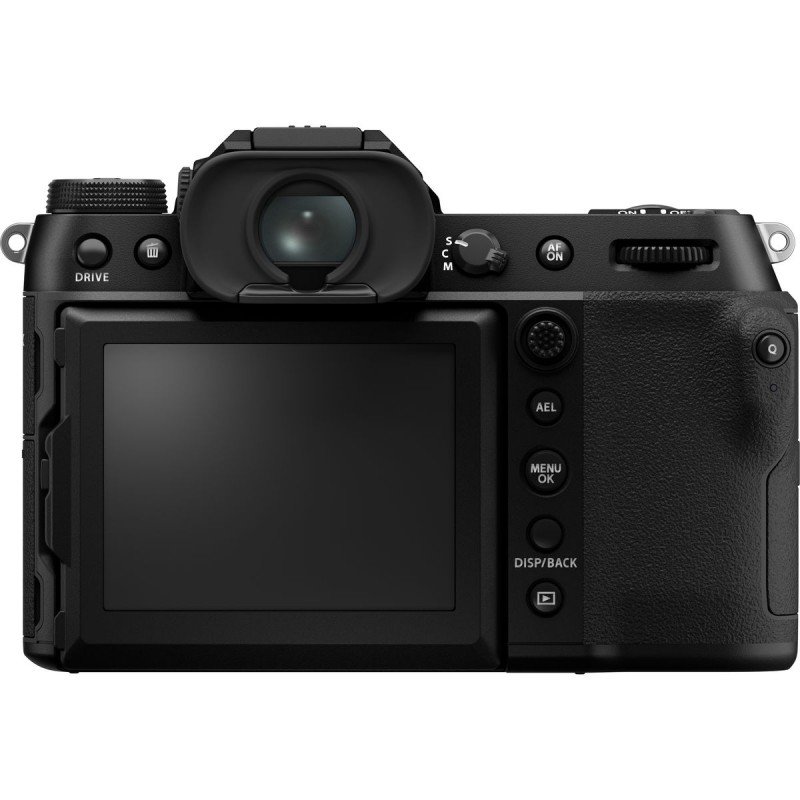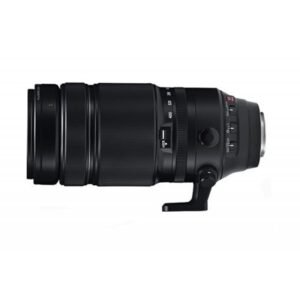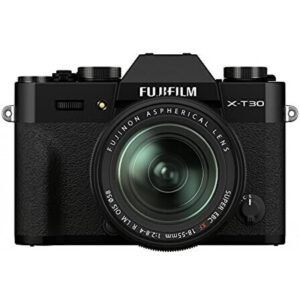GFX 50S II from Fujifilm – Professional mirrorless medium format camera
- Large 43.8 x 32.9mm sensor
- 51.4 megapixels
- Wi-Fi connectivity
- Additional display for recording information
- Water and dust resistant
- 8cm LCD touchscreen
- 5-axis image stabilizer up to 6.5 apertures
- Lightweight and compact system
- 19 film simulation modes
- Unbeatable price-performance ratio
- High-level still image recording function
- Multi Shot Pixel Shift
- Improved 14 stops dynamic range and autofocus
- Excellent lowlight properties
- Over 400 images on one battery charge
The GFX 50S Mark II also uses the “G-Mount” bayonet and has a 43.8 x 32.9 mm CMOS sensor. With its effective resolution of 51.4 million pixels, the camera delivers outstanding detail and image quality that meets the highest professional standards in all respects, for example in advertising, fashion or landscape photography.
Convincing image quality
The sensor’s 51.4 megapixels can be adjusted for various image formats, such as 4:3 (factory setting), 3:2, 1:1, 4:5, 6:7 and 6:17, which are available on large and medium format analog cameras were. The camera uses the “X-Processor Pro”, which guarantees FUJIFILM’s unique color reproduction and tonal gradations. This unparalleled photographic expressiveness is based on FUJIFILM’s rich experience with medium format cameras.
Light and compact – ideal on location
The GFX System is a mirrorless camera system that has revolutionized the concept of medium format. Compared to traditional medium format cameras, GFX is surprisingly light and compact. The robust, dust- and weather-protected housing is suitable for outdoor recordings even under adverse conditions. In terms of functionality, the camera follows in the footsteps of its predecessor with numerous buttons and dials as well as an ergonomic handle that has been optimally adapted to the camera body and lenses.
Diverse film simulations
The GFX50S II offers 19 film simulations, including the new Nostalgic Negative picture style. Images taken with this are characterized by high saturation and soft tonal reproduction. As with the other film simulations, the effects can be assessed in the electronic viewfinder or on the rear display before taking the picture in order to adjust them individually if necessary.
Built-in five-axis image stabilization
The GFX50S II features a five-axis image stabilization system (IBIS) that provides an advantage of 6.5 EV stops*3 when taking photos. This is the highest compensation of all GFX cameras to date. A powerful duo of gyrometer and acceleration sensor reacts to even the smallest movements, ensuring precise image stabilization.
FUJIFILM is revolutionizing photography with large-format cameras. While conventional medium format cameras are usually used on a tripod and require careful, careful work, the GFX50S II with the integrated image stabilizer offers outstanding image quality even when shooting handheld.
Fast and precise autofocus
The combination of high-resolution image sensor, powerful image processor “X-Processor 4” and integrated image stabilization (IBIS), in conjunction with a new AF algorithm, enables exceptionally fast and precise autofocus. Even during the AF contrast measurement, the image stabilizer compensates for unwanted sensor movements, enabling reliable focusing in all shooting situations. This means the perfect moment can be captured sharply in the picture at any time.
The “X-Processor 4” also ensures a very high AF update rate, enabling even more precise face and eye detection compared to the previous model. With a large-format sensor and the associated shallow depth of field, this fast automatic focusing is particularly advantageous, as it can be used to take expressive portraits, for example, even in dynamic situations.
Compact, lightweight and weatherproof
The FUJIFILM GFX50S II weighs only 900 grams and, with dimensions of 15 cm x 10.4 cm x 8.7 cm (WxHxD), is surprisingly compact for a camera with a large-format image sensor and integrated image stabilization. The further developed handle ensures optimally balanced handling and fatigue-free operation of the camera even when using longer telephoto focal lengths.
The robust magnesium housing is additionally reinforced around the bayonet connection to guarantee the best possible stability when using larger and heavier lenses. It is protected against splash water and dust and can be used at low temperatures down to minus 10 degrees Celsius. Its handiness and robustness allow the GFX50S II to be used in areas where conventional medium format cameras could previously hardly or not be used at all.
Familiar operating concept
The controls located on the top of the GFX50S II will be familiar to many users. The mode dial offers six user-defined settings (C1-C6) that provide instant access to frequently used functions. Right next to it, a switch allows you to quickly switch between photo and video recording.
The focus lever is now slightly flatter, which offers more comfort when working for longer periods. It also reacts more sensitively, allowing for an even more intuitive selection of focus points.
The camera has a 4.5 cm (1.8 inch) secondary LC monitor on the top, on which important shooting settings (exposure time, aperture, ISO value and exposure compensation) as well as other relevant parameters such as the remaining Capacity of the memory card can be displayed.
The 8.1 cm (3.2 inch) LCD on the back of the camera offers 100% field coverage. It can be rotated in three directions in order to be able to take photos from positions near the ground or overhead and to precisely select the image section even without an electronic viewfinder.
“Pixel Shift Multi-Shot” for 200 megapixel shots
With the “Pixel Shift Multi-Shot” function of the GFX50S II, ultra-high-resolution images with 200 megapixels can be created. The images are characterized by a high degree of detail and a natural color impression without any false colors. This makes the GFX50S II the ideal camera for documentation work in museums and archives as well as other photographic applications where maximum color and detail are important.
The Pixel Shift Multi-Shot function uses the camera’s IBIS system to successively capture 16 high-resolution images in raw data format, shifting the image sensor by 0.5 pixels after each exposure. The resulting individual photos can be combined into a single image file with a resolution of up to 200 megapixels using the “Pixel Shift Combiner” software and output losslessly as a raw file in digital negative format (DNG) for further processing. Due to their very high resolution, the images are characterized by impressive tonal value reproduction and three-dimensional representation of textures.
The image sensor is moved with maximum precision to ensure that each pixel records image information in the primary colors of red, green and blue. False colors are completely eliminated and the motif is displayed with maximum color fastness. In this way, regular 51.4 megapixel images can also be created without false colors.


















Reviews
There are no reviews yet.